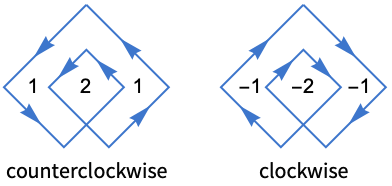WindingCount[contour,p]
gives the count of the number of times a closed curve winds around a point p.


WindingCount
WindingCount[contour,p]
gives the count of the number of times a closed curve winds around a point p.
Details and Options

- WindingCount is also known as winding number.
- WindingCount is typically used to define a polygon from self-intersecting closed curves.
- A counterclockwise revolution has a value 1 and a clockwise revolution has a value -1. For several contours, the number of revolutions around p is the sum of the number of revolutions for each contour.
- The closed curve contour is typically a collection of line segments Line[{{p1,p2},…,{pn-1,pn},{pn,p1}}] and must lie in a plane.
- For a polygon poly, WindingCount[poly,p] gives the number of times the polygon boundary curves wind around the point p.

Examples
open all close allSee Also
CrossingCount WindingPolygon CrossingPolygon Polygon Line Point
Function Repository: TurningNumber
History
Text
Wolfram Research (2019), WindingCount, Wolfram Language function, https://reference.wolfram.com/language/ref/WindingCount.html.
CMS
Wolfram Language. 2019. "WindingCount." Wolfram Language & System Documentation Center. Wolfram Research. https://reference.wolfram.com/language/ref/WindingCount.html.
APA
Wolfram Language. (2019). WindingCount. Wolfram Language & System Documentation Center. Retrieved from https://reference.wolfram.com/language/ref/WindingCount.html
BibTeX
@misc{reference.wolfram_2025_windingcount, author="Wolfram Research", title="{WindingCount}", year="2019", howpublished="\url{https://reference.wolfram.com/language/ref/WindingCount.html}", note=[Accessed: 11-January-2026]}
BibLaTeX
@online{reference.wolfram_2025_windingcount, organization={Wolfram Research}, title={WindingCount}, year={2019}, url={https://reference.wolfram.com/language/ref/WindingCount.html}, note=[Accessed: 11-January-2026]}